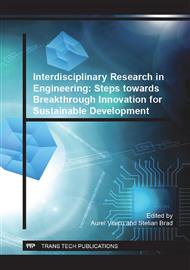[1]
3rd Generation Partnership Project; Technical Specification Group Radio Access Network; Evolved Universal Terrestrial Radio Access (E-UTRA); document 10. 2. 0 (2011-06) from: http: /www. 3gpp. org/ftp/Specs/html-info/36212. htm.
Google Scholar
[2]
European Telecommunications Standards Institute., Interaction channel for satellite distribution systems. V1. 3. 1 301 790, ETSI EN, March 2003, http: /www. etsi. org/deliver/etsi_en/301700_301799/301790/01. 03. 01_60/en_301790v010301p. pdf.
DOI: 10.17487/rfc3557
Google Scholar
[3]
R. Johannesson, and Z. Wan, A Linear Algebra Approach to Minimal Convolutional Encoders, IEEE T Inform Theory, 39 (1993) 1219-1233.
DOI: 10.1109/18.243440
Google Scholar
[4]
R. Johannesson, K. Sh. Zigangirov, Fundamentals of Convolutional Coding, IEEE Press, (1999).
Google Scholar
[5]
H. Balta, A. Isar, D. Isar, M. Balta, Mirror equivalent turbo-codes – part I, ICCEN, Hong Kong, Nov. 25-27, (2011) 25-31.
Google Scholar
[6]
C. Berrou, A. Glavieux, P. Thitimajshima, Near Shannon Limit Error –Correcting Coding and Decoding: Turbo –Codes, Proc. of ICC, Geneve, May 23-26, 2 (1993) 1064-1070.
DOI: 10.1109/icc.1993.397441
Google Scholar
[7]
C. Weiss, C. Bettstetter, S. Riedel, and D. J. Costello, Turbo decoding with tailbiting trellises, Proc. IEEE Int. Symp. Signals, Syst., Electron., Pisa, Italy, Oct. (1998) 343–348.
DOI: 10.1109/issse.1998.738095
Google Scholar
[8]
D. Divsalar and F. Pollara, Multiple Turbo Codes", MILCOM, 95, Nov. 6-8, (1995) 279-285.
DOI: 10.1109/milcom.1995.483313
Google Scholar
[9]
S.N. Crozier, New High-Spread High-Distance Interleavers for Turbo-Codes, Proc. 20th Biennial Symp. Commun., Kingston, Canada, (May. 2000) 3–7.
Google Scholar
[10]
Q J. Sun and O. Y. Takeshita, Interleavers for turbo codes using permutation polynomials over integer rings, IEEE T Inform Theory, 51 (2005) 101–119.
DOI: 10.1109/tit.2004.839478
Google Scholar
[11]
W. Koch, and A. Baier, Optimum and sub-optimum detection of coded data disturbed by time-varying intersymbol interference, GLOBECOM, (1990) 1679-1684.
DOI: 10.1109/glocom.1990.116774
Google Scholar
[12]
H. Balta, C. Douillard, M. Kovaci, The Minimum Likelihood APP Based Early Stopping Criterion for Multi-Binary Turbo Codes, Scientific Bulletin of Politehnica University of Timisoara, Transactions on Electronics and Communications, Tome 51-65, Beam 2, Timisoara, Romania, (2006).
Google Scholar
[13]
A. Matache, S. Dolinar, and F. Pollara, Stopping rules for Turbo Decoders, JPL TMO Progress Report 42-142, August 15, (2000) 1-22.
Google Scholar


